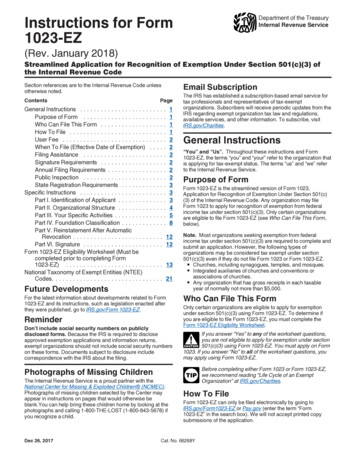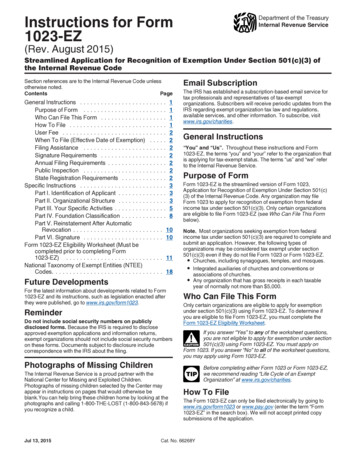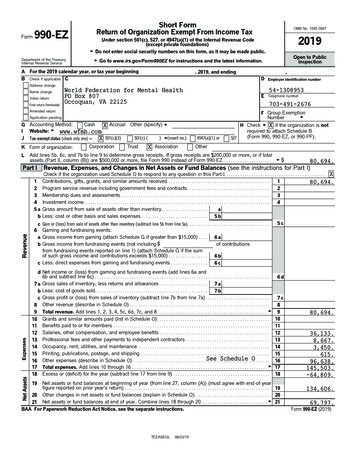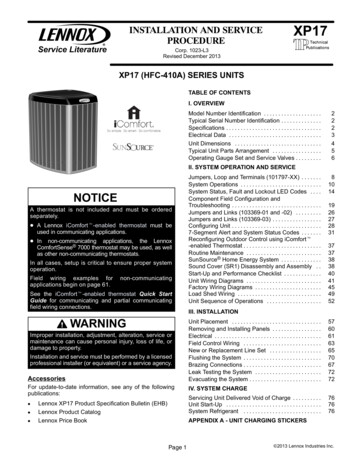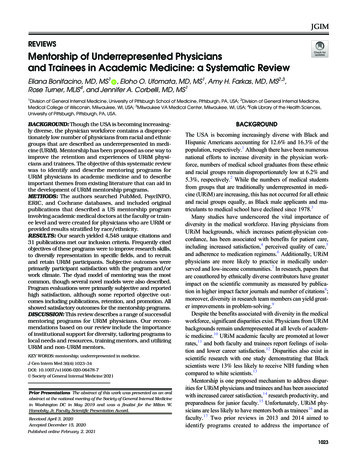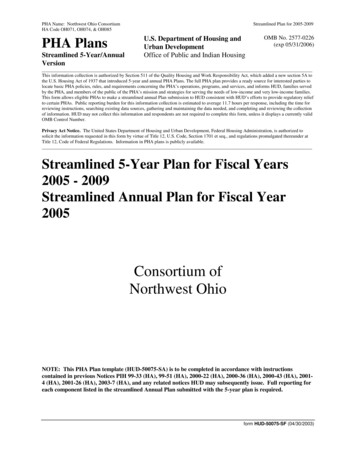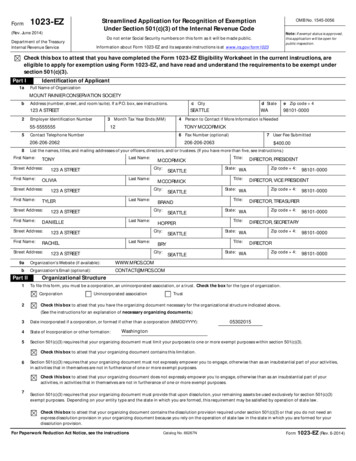
Transcription
Form1023-EZStreamlined Application for Recognition of ExemptionUnder Section 501(c)(3) of the Internal Revenue Code(Rev. June 2014)Department of the TreasuryInternal Revenue ServiceOMB No. 1545-0056Note: If exempt status is approved,this application will be open forpublic inspection.Do not enter Social Security numbers on this form as it will be made public.Information about Form 1023-EZ and its separate instructions is at www.irs.gov/form1023Check this box to attest that you have completed the Form 1023-EZ Eligibility Worksheet in the current instructions, areeligible to apply for exemption using Form 1023-EZ, and have read and understand the requirements to be exempt undersection 501(c)(3).Part I1aIdentification of ApplicantFull Name of OrganizationMOUNT RAINIER CONSERVATION SOCIETYb2Address (number, street, and room/suite). If a P.O. box, see instructions.c Cityd Statee Zip code 4123 A STREETSEATTLEWA98101-00003 Month Tax Year Ends (MM)Employer Identification Number55-555555554 Person to Contact if More Information is Needed12TONY MCCORMICK6 Fax Number (optional)Contact Telephone Number206-206-20628First Name:First Name:1123 A STREETLast Name:MCCORMICKSEATTLEBRANDCity:123 A STREETLast Name:SEATTLEHOPPERCity:123 A STREETLast Name:SEATTLEOrganization's Website (if available):Organization's Email (optional):Title:SEATTLEDIRECTOR, PRESIDENTState: WATitle:Zip code 4:Title:Zip code 4:98101-0000DIRECTOR, TREASURERState: WATitle:98101-0000DIRECTOR, VICE PRESIDENTState: WAZip code 4:98101-0000DIRECTOR, SECRETARYState: WATitle:BRYCity:123 A STREETZip code 4:98101-0000DIRECTORState: WAZip code onal StructureTo file this form, you must be a corporation, an unincorporated association, or a trust. Check the box for the type of organization.Corporation2SEATTLECity:RACHELStreet Address:Part IILast Name:DANIELLEStreet Address:First Name:123 A STREETTYLERStreet Address:MCCORMICKCity:OLIVIAStreet Address:First Name:Last Name:TONYStreet Address:b 400.00List the names, titles, and mailing addresses of your officers, directors, and/or trustees. (If you have more than five, see instructions.)First Name:9a7 User Fee Submitted206-206-2063Unincorporated associationTrustCheck this box to attest that you have the organizing document necessary for the organizational structure indicated above.(See the instructions for an explanation of necessary organizing documents.)053020153Date incorporated if a corporation, or formed if other than a corporation (MMDDYYYY):4State of Incorporation or other formation:5Section 501(c)(3) requires that your organizing document must limit your purposes to one or more exempt purposes within section 501(c)(3).WashingtonCheck this box to attest that your organizing document contains this limitation.6Section 501(c)(3) requires that your organizing document must not expressly empower you to engage, otherwise than as an insubstantial part of your activities,in activities that in themselves are not in furtherance of one or more exempt purposes.Check this box to attest that your organizing document does not expressly empower you to engage, otherwise than as an insubstantial part of youractivities, in activities that in themselves are not in furtherance of one or more exempt purposes.7Section 501(c)(3) requires that your organizing document must provide that upon dissolution, your remaining assets be used exclusively for section 501(c)(3)exempt purposes. Depending on your entity type and the state in which you are formed, this requirement may be satisfied by operation of state law.Check this box to attest that your organizing document contains the dissolution provision required under section 501(c)(3) or that you do not need anexpress dissolution provision in your organizing document because you rely on the operation of state law in the state in which you are formed for yourdissolution provision.For Paperwork Reduction Act Notice, see the instructionsCatalog No. 66267NForm 1023-EZ (Rev. 6-2014)
Page 2Form 1023-EZ (Rev. 6-2014)Part IIIYour Specific ActivitiesC361 Enter the appropriate 3-character NTEE Code that best describes your activities (See the instructions):2 To qualify for exemption as a section 501(c)(3) organization, you must be organized and operated exclusively to further one or more of the following purposes. Bychecking the box or boxes below, you attest that you are organized and operated exclusively to further the purposes indicated. Check all that raryTesting for public safetyTo foster national or international amateur sports competitionPrevention of cruelty to children or animals3 To qualify for exemption as a section 501(c)(3) organization, you must:Refrain from supporting or opposing candidates in political campaigns in any way.Ensure that your net earnings do not inure in whole or in part to the benefit of private shareholders or individuals (that is, board members, officers, keymanagement employees, or other insiders).Not further non-exempt purposes (such as purposes that benefit private interests) more than insubstantially.Not be organized or operated for the primary purpose of conducting a trade or business that is not related to your exempt purpose(s).Not devote more than an insubstantial part of your activities attempting to influence legislation or, if you made a section 501(h) election, not normally makeexpenditures in excess of expenditure limitations outlined in section 501(h).Not provide commercial-type insurance as a substantial part of your activities.Check this box to attest that you have not conducted and will not conduct activities that violate these prohibitions and restrictions.4 Do you or will you attempt to influence legislation?(If yes, consider filing Form 5768. See the instructions for more details.)YesNo5 Do you or will you pay compensation to any of your officers, directors, or trustees?(Refer to the instructions for a definition of compensation.)YesNo6 Do you or will you donate funds to or pay expenses for individual(s)?YesNo7 Do you or will you conduct activities or provide grants or other assistance to individual(s) or organization(s) outside the UnitedStates?YesNo8 Do you or will you engage in financial transactions (for example, loans, payments, rents, etc.) with any of your officers, directors,or trustees, or any entities they own or control?YesNo9 Do you or will you have unrelated business gross income of 1,000 or more during a tax year?YesNo10 Do you or will you operate bingo or other gaming activities?YesNo11 Do you or will you provide disaster relief?YesNoPart IVFoundation ClassificationPart IV is designed to classify you as an organization that is either a private foundation or a public charity. Public charity status is a morefavorable tax status than private foundation status.1 If you qualify for public charity status, check the appropriate box (1a - 1c below) and skip to Part V below.aCheck this box to attest that you normally receive at least one-third of your support from public sources or you normally receive at least 10 percent ofyour support from public sources and you have other characteristics of a publicly supported organization. Sections 509(a)(1) and 170(b)(1)(A)(vi).bCheck this box to attest that you normally receive more than one-third of your support from a combination of gifts, grants, contributions, membershipfees, and gross receipts (from permitted sources) from activities related to your exempt functions and normally receive not more than one-third of yoursupport from investment income and unrelated business taxable income. Section 509(a)(2).cCheck this box to attest that you are operated for the benefit of a college or university that is owned or operated by a governmental unit. Sections509(a)(1) and 170(b)(1)(A)(iv).2 If you are not described in items 1a - 1c above, you are a private foundation. As a private foundation, you are required by section 508(e) to have specificprovisions in your organizing document, unless you rely on the operation of state law in the state in which you were formed to meet these requirements. Thesespecific provisions require that you operate to avoid liability for private foundation excise taxes under sections 4941-4945.Check this box to attest that your organizing document contains the provisions required by section 508(e) or that your organizing document does notneed to include the provisions required by section 508(e) because you rely on the operation of state law in your particular state to meet therequirements of section 508(e). (See the instructions for explanation of the section 508(e) requirements.)Form 1023-EZ (Rev. 6-2014)
Page 3Form 1023-EZ (Rev. 6-2014)Part VReinstatement After Automatic RevocationComplete this section only if you are applying for reinstatement of exemption after being automatically revoked for failure to file requiredannual returns or notices for three consecutive years, and you are applying for reinstatement under section 4 or 7 of Revenue Procedure2014-11. (Check only one box.)Check this box if you are seeking retroactive reinstatement under section 4 of Revenue Procedure 2014-11. By checking this box, you attest that youmeet the specified requirements of section 4, that your failure to file was not intentional, and that you have put in place procedures to file requiredreturns or notices in the future. (See the instructions for requirements.)12Check this box if you are seeking reinstatement under section 7 of Revenue Procedure 2014-11, effective the date you are filling this application.Part VISignatureI declare under the penalties of perjury that I am authorized to sign this application on behalf of the above organizationand that I have examined this application, and to the best of my knowledge it is true, correct, and complete.TONY MCCORMICK(Type name of signer)DIRECTOR, PRESIDENT(Type title or authority of signer)06052015(Date)Form 1023-EZ (Rev. 6-2014)
Form 1023-EZ Eligibility Worksheet(Must be completed prior to completing Form 1023-EZ)If you answer “Yes” to any of the worksheet questions, you are not eligible to apply for exemption under section 501(c)(3)using Form 1023-EZ. You must apply on Form 1023. If you answer “No” to all of the worksheet questions, you may applyusing Form 1023-EZ.1. Do you project that your annual gross receipts will exceed 50,000 in any of thenext 3 years?YesNo2. Have your annual gross receipts exceeded 50,000 in any of the past 3 years?YesNo3. Do you have total assets in excess of 250,000?YesNoYesNoYesNoYesNoGross receipts are the total amounts the organization received from all sources during itsannual accounting period, without subtracting any costs or expenses. You shouldconsider this year and the next two years.Total assets includes cash, accounts receivable, inventories, bonds and notesreceivable, corporate stocks, loans receivable, other investments, depreciable anddepletable assets, land, buildings, equipment, and any other assets.4. Were you formed under the laws of a foreign country (United States territories andpossessions are not considered foreign countries)?You are formed under the laws of a foreign country if you are not formed under the lawsof (1) the United States, its states, territories, or possessions; (2) federally recognizedIndian tribal or Alaskan native governments; or (3) the District of Columbia.5. Is your mailing address in a foreign country (United States territories andpossessions are not considered foreign countries)?Your mailing address is the address where all correspondence will be sent.6. Are you a successor to, or controlled by, an entity suspended under section501(p) (suspension of tax-exempt status of terrorist organizations)?Section 501(p)(1) suspends the exemption from tax under section 501(a) of anyorganization described in section 501(p)(2). An organization is described in section 501(p)(2) if the organization is designated or otherwise individually identified (1) under certainprovisions of the Immigration and Nationality Act as a terrorist organization or foreignterrorist organization; (2) in or pursuant to an Executive Order which is related to terrorismand issued under the authority of the International Emergency Economic Powers Act orsection 5 of the United Nations Participation Act of 1945 for the purpose of imposing onsuch organization an economic or other sanction; or (3) in or pursuant to an ExecutiveOrder issued under the authority of any federal law, if the organization is designated orotherwise individually identified in or pursuant to the Executive Order as supporting orengaging in terrorist activity (as defined in the Immigration and Nationality Act) orsupporting terrorism (as defined in the Foreign Relations Authorization Act) and theExecutive Order refers to section 501(p)(2).Under section 501(p)(3) of the Code, suspension of an organization’s tax exemptionbegins on the date of the first publication of a designation or identification with respect tothe organization, as described above, or the date on which section 501(p) was enacted,whichever is later. This suspension continues until all designations and identifications ofthe organization are rescinded under the law or Executive Order under which suchdesignation or identification was made.Form 1023-EZ Instructions-11-
7. Are you a limited liability company (LLC)?YesNoYesNoYesNoYesNoAnswer “Yes” if you are organized as an LLC under the laws of the state in which youwere formed.8. Are you a successor to a for-profit entity?You are a successor if you have:1. Substantially taken over all of the assets or activities of a for-profit entity;2. Been converted or merged from a for-profit entity; or3. Installed the same officers, directors, or trustees as a for-profit entity that no longerexists.9. Were you previously revoked or are you a successor to a previously revokedorganization (other than an organization the tax-exempt status of which wasautomatically revoked for failure to file a Form 990-series return for threeconsecutive years)?Do not check “Yes” if your previous revocation, or your predecessor’s revocation, was anautomatic revocation (pursuant to section 6033(j)) for failing to satisfy Form 990-seriesfiling requirements for three consecutive years.10. Are you a church or a convention or association of churches described in section170(b)(1)(A)(i)?There is no single definition of the word “church” for tax purposes; however, thecharacteristics generally attributed to churches include:A distinct legal existence,A recognized creed and form of worship,A definite and distinct ecclesiastical government,A formal code of doctrine and discipline,A distinct religious history,A membership not associated with any other church or denomination,Ordained ministers ministering to the congregation,Ordained ministers selected after completing prescribed courses of study,A literature of its own,Established places of worship,Regular congregations,Regular religious services,Sunday schools for the religious instruction of the young, andSchools for the preparation of ministers.Although it is not necessary that each of the above characteristics be present, acongregation or other religious membership group that meets regularly for religiousworship is generally required. A church includes mosques, temples, synagogues, andother forms of religious organizations. For more information, see Publication 1828.-12-Form 1023-EZ Instructions
11. Are you a school, college, or university described in section 170(b)(1)(A)(ii)?YesNoYesNoAn organization is a school if it:1. Presents formal instruction as its primary function,2. Has a regularly scheduled curriculum,3. Has a regular faculty of qualified teachers,4. Has a regularly enrolled student body, and5. Has a place where educational activities are regularly carried on.The term “school” includes primary, secondary, preparatory, high schools, colleges, anduniversities. It does not include organizations engaged in both educational andnon-educational activities, unless the latter are merely incidental to the educationalactivities.12. Are you a hospital or medical research organization described in section 170(b)(1)(A)(iii) or a hospital organization described in section 501(r)(2)(A)(i)?An organization is a hospital described in section 170(b)(1)(A)(iii) if its principal purposeor function is providing medical or hospital care, or medical education or research.Medical care includes treatment of any physical or mental disability or condition, on aninpatient or outpatient basis. Thus, if an organization is a rehabilitation institution,outpatient clinic, or community mental health or drug treatment center, it is a hospital if itsprincipal function is providing treatment services as described above.A hospital does not include convalescent homes, homes for children or the aged, orinstitutions whose principal purpose or function is to train handicapped individuals topursue a vocation.An organization is a medical research organization described in section 170(b)(1)(A)(iii) ifits principal purpose or function is the direct, continuous, and active conduct of medicalresearch in conjunction with a hospital. The hospital with which the organization isaffiliated must be described in section 501(c)(3), a federal hospital, or an instrumentality ofa governmental unit, such as a municipal hospital.An organization is a hospital organization described in section 501(r)(2)(A)(i) if theorganization operates a facility which is required by a state to be licensed, registered, orsimilarly recognized as a hospital.Form 1023-EZ Instructions-13-
13. Are you applying for exemption as a cooperative hospital service organizationunder section 501(e)?YesNoYesNoA cooperative hospital service organization described in section 501(e) is organized andoperated on a cooperative basis to provide its section 501(c)(3) hospital members one ormore of the following activities.Data processing.Purchasing (including purchasing insurance on a group basis).Warehousing.Billing and collection (including purchasing patron accounts receivable on a recoursebasis).Food.Clinical.Industrial ord center.Personnel (including selecting, testing, training, and educating personnel) services.A cooperative hospital service organization must also meet certain other requirementsspecified in section 501(e).14. Are you applying for exemption as a cooperative service organization of operatingeducational organizations under section 501(f)?An organization is a cooperative service organization of operating educationalorganizations if it is organized and operated solely to provide investment services to itsmembers. Those members must be organizations described in section 170(b)(1)(A)(ii) or(iv) that are tax exempt under section 501(a) or whose income is excluded from taxationunder section 115.-14-Form 1023-EZ Instructions
15. Are you applying for exemption as a qualified charitable risk pool under section501(n)?A qualified charitable risk pool is treated as organized and operated exclusively forcharitable purposes. Check the appropriate box to indicate whether you are a charitablerisk pool. A qualified charitable risk pool is an organization that:1. Is organized and operated only to pool insurable risks of its members (not includingrisks related to medical malpractice) and to provide information to its members aboutloss control and risk management,2. Consists only of members that are section 501(c)(3) organizations exempt from taxunder section 501(a),3. Is organized under state law authorizing this type of risk pooling,4. Is exempt from state income tax (or will be after qualifying as a section 501(c)(3)organization),5. Has obtained at least 1,000,000 in startup capital from nonmember charitableorganizations,6. Is controlled by a board of directors elected by its members, and7. Is organized under documents requiring that:a. Each member be a section 501(c)(3) organization exempt from tax under section501(a),b. Each member that receives a final determination that it no longer qualifies undersection 501(c)(3) notify the pool immediately, andc. Each insurance policy issued by the pool provide that it will not cover eventsoccurring after a final determination described in (b).Form 1023-EZ Instructions-15-YesNo
16. Are you requesting classification as a supporting organization under section509(a)(3)?YesNoYesNo18. Do you or will you invest 5% or more of your total assets in securities or fundsthat are not publicly traded?YesNo19. Do you participate, or intend to participate, in partnerships (including entitiestreated as partnerships for federal tax purposes) in which you share profits andlosses with partners other than section 501(c)(3) organizations?YesNo20. Do you sell, or intend to sell carbon credits or carbon offsets?YesNo21. Are you a Health Maintenance Organization (HMO)?YesNoA supporting organization (as defined in section 509(a)(3)) differs from the other types ofpublic charities described in section 509. Instead of describing an organization thatconducts a particular kind of activity or that receives financial support from the generalpublic, section 509(a)(3) describes organizations that have established certainrelationships in support of public charities described in section 509(a)(1) or 509(a)(2).Thus, an organization can qualify as a supporting organization (and not be classified as aprivate foundation) even though it may be funded by a single donor, family, or corporation.This kind of funding ordinarily would indicate private foundation status, but a section 509(a)(3) organization has limited purposes and activities, and gives up a significant degree ofindependence. A supporting organization is an organization that:1. Is organized and operated exclusively for the benefit of, to perform the functions of, orto carry out the purposes of one or more specified organizations as described insection 509(a)(1) or 509(a)(2). These section 509(a)(1) and 509(a)(2) organizationsare commonly called publicly supported organizations.2. Has one of three types of relationships with one or more organizations described insection 509(a)(1) or 509(a)(2). It must be:a. Operated, supervised, or controlled by one or more section 509(a)(1) or 509(a)(2)organizations (Type I supporting organization);b. Supervised or controlled in connection with one or more section 509(a)(1) or509(a)(2) organizations (Type II supporting organization); orc. Operated in connection with one or more section 509(a)(1) or 509(a)(2)organizations (Type III supporting organization).3. Is not controlled directly or indirectly by disqualified persons (as defined in section4946) other than foundation managers and other than one or more organizationsdescribed in section 509(a)(1) or 509(a)(2).See Publication 557 for more information.17. Is a substantial purpose of your activities to provide assistance to individualsthrough credit counseling activities such as budgeting, personal finance, financialliteracy, mortgage foreclosure assistance, or other consumer credit areas?These activities involve the education of the consumer on budgeting, personal finance,financial literacy, mortgage foreclosure assistance, or other consumer credit areas. It mayalso involve assisting the consumer in consolidating debt and negotiating betweendebtors and creditors to lower interest rates and waive late and over-limit fees.-16-Form 1023-EZ Instructions
22. Are you an Accountable Care Organization (ACO), or do you engage in or intendto engage in ACO activities?YesNoYesNoYesNoYesNoYesNoACOs are entities formed by groups of physicians, hospitals, and other health careservice providers and suppliers to manage and coordinate the care provided to patients.For a discussion of tax law issues relating to ACOs, see Notice 2011-20 and FS-2011-11,available at -Accountable-Care-Organizations.23. Do you maintain or intend to maintain one or more donor advised funds?In general, a donor advised fund is a fund or account that is owned and controlled by theorganization but that is separately identified by reference to contributions of a donor ordonors and with respect to which a donor (or any person appointed or designated by thedonor) has or expects to have advisory privileges concerning the distribution orinvestment of amounts held in the fund or account by reason of the donor’s status as adonor. For additional information, see Publication 557.Check “No” if you are a governmental unit referred to in section 170(c)(1) or a privatefoundation referred to in section 509(a).24. Are you organized and operated exclusively for testing for public safety andrequesting a foundation classification under section 509(a)(4)?Generally, these organizations test consumer products to determine their acceptabilityfor use by the general public.25. Are you requesting classification as a private operating foundation?Private foundations lack general public support. What distinguishes a private operatingfoundation from other private foundations is that it engages directly in the active conductof charitable, religious, educational, and similar activities (as opposed to indirectly carryingout these activities by providing grants to individuals or other organizations). Privateoperating foundations are subject to more favorable rules than other private foundations interms of charitable contribution deductions and attracting grants from private foundations.However, to be classified as a private operating foundation, an organization must meetcertain tests. Additional information about private operating foundations is available atwww.irs.gov/Charities- g-Foundations.26. Are you applying for retroactive reinstatement of exemption under section 5 or 6of Rev. Proc. 2014-11, after being automatically revoked?Only organizations applying for reinstatement under section 4 or 7 of Rev. Proc.2014-11 may use Form 1023-EZ. If you are applying for retroactive reinstatement undersection 5 or 6 of Rev. Proc. 2014-11, you must submit the full Form 1023 along with theappropriate reasonable cause statement and a statement confirming you have filed therequired annual returns as described in the revenue procedure.Form 1023-EZ Instructions-17-
Form 1023-EZ (Rev. 6-2014) Page 2 Part III Your Specific Activities 1 Enter the appropriate 3-character NTEE Code that best describes your activities (See the instructions): To qualify for exemption as a section 501(c)(3) organization, you must be organized and operated exclusively to further one or more of the following purposes.
